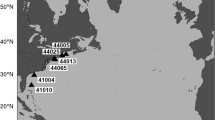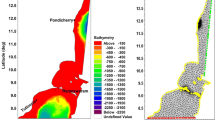Abstract
The methods of wave forecasting at short fetches and wind forecasting in close proximity to the water/surface border are developed. The preliminary results of atmospheric model WRF and wave model WAVEWATCH III coupling are presented. Coupling of WW3 and WRF models is implemented using the modified code of OASIS software package to perform the exchange of time-varying Charnock parameter between the models. WRF LES simulations coupled to the wave model WW3 show a noticeable improvement in the quality of calculation of the wind speed.
Access provided by Autonomous University of Puebla. Download chapter PDF
Similar content being viewed by others
Keywords
1 Introduction
Determining the parameters of wind and surface waves in large and middle-sized inland water bodies is an important practical task. In particular, waves and wind conditions are the most important factors determining the erosion of the coast, their consideration is necessary to ensure the safety of navigation, especially small vessels. A regular publicly available wind and wave forecast is organized on NOAA’s Great lakes website (https://www.weather.gov/greatlakes/). Parameters of wind waves to a large extent determine the surface condition of the reservoir and have an impact on the thermo-hydrodynamic regime of the reservoir and turbulent flows in the surface layer of the atmosphere, contributing to the features of the microclimate of adjacent areas.
However, when modeling wind and waves in inland waters of small and medium size with typical linear dimensions of not more than 100 km, a number of problems remain. The spatial resolution of the calculated surface wave characteristics and atmospheric parameters used for global projections varies between 0.205° and 2.5°, which is rough enough for inland waters. Attempts of regular usage of global models for local forecasting on a smaller grid without special adaptation usually lead to results that are very different from the measurement data, since the conditions of the reservoir have a number of features, primarily small wind fetches.
2 Method
In the previous works (Kuznetsova et al. 2016) the features of the development of surface waves on short fetches typical for the conditions of inland waters were studied on the basis of adaptation of existing global wave models to the conditions of inland waters. For example, WAVEWATCH III (WW3) ((WW3DG) 2016), which was focused primarily on ocean conditions.
The accuracy of the wave model results is highly dependent on the wind model used for forcing. The requirements for meteorological models are increasing for enclosed coastal waters or enclosed basins, where wind fields are highly dependent on local conditions that are not described by global meteorological models. Their reanalysis data have spatial variability, which allows more accurate modeling of the waves. But in inland water bodies this approach is not applicable due to the too low spatial resolution. To account for the complex orography of coastal waters and enclosed basins, numerical weather prediction models are created that use mathematical models of the atmosphere and ocean to predict weather based on current weather conditions.
Thus, a method of taking into account the spatial variability using wind forcing from the WRF model is proposed. Setting the wind field from WRF with high spatial resolution provides the possibility of predicting waves with high resolution, which is a popular solution for both inland water bodies and coastal zones (Rusu et al. 2014).
This method of specifying wind pumping from the atmospheric WRF model was carried out, for example, in (Alves et al. 2014). In addition, a regional adaptation of the WRF atmospheric model is presented in (Kuznetsova et al. 2019). Briefly, model settings can be described in a Table 1.
The development of methods for forecasting of microclimate and weather conditions is possible with the use of adapted and linked models and is presented in this paper. This is a new direction of research, “coupled models”, implemented, for example, in (Chen et al. 2013). The idea is that wind waves affect the atmospheric properties of surface wind and heat flows through surface roughness, and surface roughness, in turn, affect the parameters of the atmosphere. Models with two-way coupling (“2-way coupling”) allow taking into account the two-way interaction in the atmosphere-water system.
The two-way feedback method between WW3 and WRF models is being developed and implemented. The area containing the Gorky reservoir is chosen to test the method.
Coupling of WW3 and WRF models is implemented using the OASIS software package (Anthony et al. 2017), which is modified to allow the exchange of Charnock parameter between models. Charnock parameter is responsible for water surface roughness and can be used for more accurate prediction not as a constant but as a time-varying parameter. Modification of the source code of the models is performed to add the possibility of exchanging Charnock parameter between the models, as well as the possibility of exchanging wind velocity at a standard meteorological altitude of 10 m between the models. The data about these parameters obtained in one of the models is taken by the other at each time step and used instead of the initial data, thus creating feedback between the models.
Thus, in this paper, the preliminary results of calculating the wind velocity using the atmospheric model coupled with the wave model are presented. The 10 m wind speed distribution is compared at the same moment for the WRF LES simulation and WRF LES coupled with WW3 (Fig. 1). Option LES, i.e. Large-Eddy Simulation enabled the calculation of the first three domains under the Yonsei University (YSU) scheme for surface boundary layer and as surface layer modeling is based on similarity theory of Monin-Obukhov, taking into account the viscous sublayer in the Carlson-Boland form. Simulation of wind speed in the fourth domain is made in the planetary boundary layer as well, and for the near-surface layer, Monin-Obukhov parameterization is used.
WRF LES coupled with WW3 means that the wind speed calculated by the large-eddy simulation method in the WRF model was used as the “forcing” for the WW3 wave model. The Charnock parameter values obtained by the wave model were taken in the next calculation by the WRF model at each time step. This is so-called feedback. The wind wave interaction implies, first of all, the momentum exchange in the water-atmosphere system. The value of the wave momentum flux is determined by the roughness of the wavy surface. Setting the exact roughness of the excited surface to the atmospheric model will allow us to refine the calculated atmospheric parameters.
3 Results and Discussion
The results of simulations obtained in the coupled models allowed to achieve better spatial variability compared to the WRF LES simulation results.
Then, the wind velocity and direction obtained at the point of measurement were compared from four sources. First, the reference data were in situ measurements made by our group on the test day. Second, CFSv2 reanalysis data of the highest accuracy of 0.205° available to date were used. Third, calculations were made by the WRF with large-eddy simulation used (WRF LES). Fourth, WRF LES coupled with WW3.
A comparison of the behavior of 10 m wind speed and direction, calculated by using different options is shown in Fig. 2. Here, the time starts in advance and corresponds to the beginning of the simulation. The zero point corresponds to the Moscow time 11:00 on the test day 08/08/2017 and is close to the time of the beginning of the in situ measurements. The results of the WRF run are given for the test day 08.08.17. The comparison shows that the use of the considered WRF calculations is better consistent with the experiment than the direct use of reanalysis. The calculations of WRF LES showed good time variability corresponding to in situ observations as for the velocity module (see Fig. 2a), and for its direction (see Fig. 2b). Although the experimental data and WRF LES are much better in magnitude, there is some inconsistency in them. In particular, a maximum of 150 min in the experimental data corresponds to a minimum in the model data. The reason for this inconsistency is that in reality the role of feedback in the wave-wind system is great, the effect of waves on the wind is taken into account in coupling models (WRF-LES (coupled)).
WRF LES calculations, passed through the coupling with the wave model WW3 (“coupled”), show a noticeable improvement in the quality of calculation of the wind speed. In this case, the value of wind speed directions has a deviation from the measurement data. More calculations will be performed for a set of statistics. However, preliminary data suggests that the exchange of parameters at each step of the calculations of both models leads to increase of the accuracy of calculations and reduce the dependence of the simulation results on the input data from reanalysis.
4 Conclusions
The WRF model was applied to a region containing a medium-sized inland body of water, and the region containing the Gorky Reservoir was selected as a test area. WRF modeling was carried out for 4 nested domains with a minimum cell size of 1 km. The input parameter was a reanalysis of CFSv2. Large Eddy Simulation (LES) approach was used. The results were compared with in situ measurements. The coupling of the WRF atmospheric model and WAVEWATCH III wave model is performed. WRF LES calculations, passed through the coupling with WAVEWATCH III, show a noticeable improvement in the quality of calculation of the wind speed.
References
Alves J-HG, Chawla A, Tolman HL, Schwab D, Lang G, Mann G (2014) The operational implementation of a Great Lakes wave forecasting system at NOAA/NCEP. Weather Forecast 29(6):1473–1497
Anthony C, Valcke S, Coquart L (2017) Development and performance of a new version of the OASIS coupler, OASIS3-MCT_3. 0. Geosci Model Dev 10(9):3297–3308
Chen SS, Zhao W, Donelan MA, Tolman HL (2013) Directional wind–wave coupling in fully coupled atmosphere–wave–ocean models: results from CBLAST-Hurricane. J Atmos Sci 70(10):3198–3215
Kuznetsova AM, Baydakov GA, Papko VV, Kandaurov AA, Vdovin MI, Sergeev DA, Troitskaya YuI (2016) Adjusting of wind input source term in WAVEWATCH III model for the middle-sized water body on the basis of the field experiment. Adv Meteorol 1:1–13. article ID 574602
Kuznetsova A, Baydakov G, Sergeev D, Troitskaya Yu (2019) High-resolution waves and weather forecasts using adapted WAVEWATCH III and WRF models. J Phys Conf Ser 1163:012031
Rusu L, Bernardino M, Guedes Soares C (2014) Wind and wave modelling in the Black Sea. J Oper Oceanography 7(1):5–20
The WAVEWATCH III Development Group (WW3DG) (2016) User manual and system documentation of WAVEWATCH III (R) version 5.16. Technical Note 329, NOAA/NWS/NCEP/MMAB, College Park, MD, USA, 2016. 326 pp. Appendices
Acknowledgements
A. Kuznetsova acknowledges Russian Science Foundation grant 19-17-00209 for the support of the development of the forecasting methods at short fetches. Yu. Troitskaya acknowledges RFBR grant 17-05-41117 for the support of the development of the coupling method.
Author information
Authors and Affiliations
Corresponding author
Editor information
Editors and Affiliations
Rights and permissions
Copyright information
© 2021 The Author(s), under exclusive license to Springer Nature Switzerland AG
About this chapter
Cite this chapter
Loktev, F., Kuznetsova, A., Baydakov, G., Troitskaya, Y. (2021). Development of Methods for Wind Speed and Wave Parameters Forecasting in Inland Waters. In: Chaplina, T. (eds) Processes in GeoMedia - Volume II. Springer Geology. Springer, Cham. https://doi.org/10.1007/978-3-030-53521-6_4
Download citation
DOI: https://doi.org/10.1007/978-3-030-53521-6_4
Published:
Publisher Name: Springer, Cham
Print ISBN: 978-3-030-53520-9
Online ISBN: 978-3-030-53521-6
eBook Packages: Earth and Environmental ScienceEarth and Environmental Science (R0)






